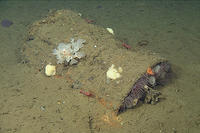-
Guards at U.K. nuclear weapons facility slept on the job, skipped routine patrols
Police officers of the U.K. Ministry of Defense police, assigned to guard Britain’s nuclear weapons, are under investigation after it has been reported that they had slept on the job and failed to complete routine patrols at a nuclear weapons facility. The Atomic Weapons Establishment (AWE) in Burghfield, Berkshire, is the location of the complex final assembly of nuclear weapons, and also where the U.K. nuclear warheads are maintained and decommissioned.
-
-
Boston Police has suspended use of license plate scanners
TheBoston Police Department (BPD) has suspended its use of license plate scanners which enable law enforcement agencies automatically to scan vehicles for traffic or criminal violations. The announcement comes after an investigation raised privacy concerns regarding whether BPD is capable of securing the data collected from the license plate scanners. The investigation also revealed that information on wanted vehicles captured by the scanners was not followed.
-
-
Shot spotting system helps Stockton, Calif. Police reduce gunfire
ShotSpotter sensors detect gunfire, then immediately transmit a signal to control center where technicians use triangulation to locate the spot of origin of the firing to within five to ten feet. The technician reports the location within thirty to forty seconds to the police to dispatch officers to the scene. Stockton, California police has been using ShotSpotter for nine months now, and the police chief says the system has helped reduce gunfire in the covered area by fifty percent.
-
-
Hezbollah blames Israel, but assassinated leader had many enemies

Hassan al-Lakkis, the man considered to be Hezbollah’s tech expert, known for his expertise with drones, bombs, and other gadgets, was assassinated near his home last week. Al-Lakkis’s body was not yet cold when Hezbollah operatives began to blame Israel for the assassination, despite al-Lakkis’ long list of enemies. Hezbollah’s support of Syrian President Bashar al-Assad has gained it a long list of enemies, and many experts insist that the assassination of al-Lakkis does not resemble an Israeli-styled operation.
-
-
EU to fund improved C3IS capabilities for African-led security operations
The EU on Friday confirm it will provide 12.5 million euros through its African Peace Facility to improve the command, control, communication, and information system (C3IS) used in African-led peace support operations. Since 2004 the EU has provided 1.1 billion euros to support peace and security operations in Africa.
-
-
Longstanding forensic identification technique questioned
Forensic experts have long used the shape of a person’s skull to make positive identifications of human remains. Those findings, however, may now be called into question, since a new study shows that there is not enough variation in skull shapes to make a positive ID.
-
-
Survey of deep-sea chemical munitions dump off California finds no chemical weapons

Since the Second World War, U.S. nautical charts have shown seven “chemical munitions dumping areas” along the Pacific Coast between San Francisco and the Mexican border. Little or no information, however, is available about the amount, location, or nature of the materials that were dumped at most of these sites. Researchers from the Monterey Bay Aquarium Research Institute (MBARI) conducted a detailed survey of one supposed deep‐water dump site off Southern California, and found that it contained no chemical munitions. The researchers conclude that not all sites marked as chemical munitions dumps may actually have been used for this purpose.
-
-
U.S. “bomb library” marks 10-year anniversary
It has been ten years since the FBI established the Terrorist Explosive Device Analytical Center (TEDAC), and since that time the multi-agency operation — sometimes referred to as America’s bomb library — has become an important tool in the nation’s fight against terrorism. Since its creation in 2003, TEDAC has examined more than 100,000 IEDs from around the world and currently receives submissions at the rate of 800 per month. Two million items have been processed for latent prints — half of them this year alone.
-
-
India-Pakistan nuclear war would lead to world-wide famine: study
An India-Pakistan nuclear war may see the use of about 100 Hiroshima-size bombs – about half of India and Pakistan’s nuclear arsenals. A new study says that a nuclear exchange on such a scale would “probably cause the end (of) modern industrial civilization as we know it” by subjecting about two billion people to the risk of starvation, and causing massive economic and social disruptions far away from the theater of war. Among the consequences of a nuclear exchange: Chinese winter wheat production could decline by 50 percent during the first year and by more than 30 percent over ten years; there would be a 21 percent decline in Chinese middle-season rice production during the first four years and an average 10 percent decline in the following six years; corn and soybean production in the United States would decline by 10 percent on average for ten years.
-
-
Africa’s Sahel region threatened by terrorism, organized crime: Ban Ki-moon
Terrorism, trafficking in arms, drugs, and people, and other transnational forms of organized crime are threatening security in Africa’s vast sub-Saharan Sahel region, Secretary-General Ban Ki-moon warned the Security Council yesterday. He called for continued strengthening of The UN Multidimensional Integrated Stabilization Mission in Mali (MINUSMA), a 12,600-strong force set up by the Council in April and authorized “to use all necessary means” to carry out security-related stabilization tasks, protect civilians, UN staff, and cultural artefacts in the cou8ntry, and create the conditions for provision of humanitarian aid.
-
-
Improving the national ballistic data base
A team of researchers identified a number of areas of improvement in a national database of forensic ballistics evidence used to link guns to violent crimes. The report, just released by the National Institute of Justice, already has led to improvements in the system called the National Integrated Ballistic Information Network (NIBIN), which is operated by the Bureau of Alcohol, Tobacco, Firearms and Explosives (ATF).
-
-
Police cell-phone tracking raises privacy concerns

Law enforcement agencies around the country are using the International Mobile Subscriber Identity locator (IMSI catcher), known as Stingray, to track cellphone users for the purpose of assisting criminal investigations. Stingray masquerades as a cellphone tower, tricking phones into sending it a signal that law enforcement can later use to identify the serial number of the phone and track the subscriber or cellphone user. Privacy advocates are worried about widespread police tracking of cellphones and violations of privacy.
-
-
Lawmakers: Old plastic gun law has not kept pace with technology
The U.S. House of Representativesvoted last Tuesday to renew the 25-year old Undetectable Firearms Actwhich prohibits firearms that can evade metal detectors and X-ray machines. Law enforcement agencies say that developments in 3D printing make the law insufficient, and lawmakers who proposed amending the Act say that the only way to make such guns detectable is to require that at least one component of the firing mechanism in a plastic gun contain enough metal to be detectable in a magnetometer — and that that component be undetachable. The NRA opposes these requirements, saying that they would infringe on the Second Amendment rights of citizens.
-
-
U.S. aircraft to fly African troops to the Central African Republic mission
U.S. military aircraft will fly African and European peacekeepers to the Central African Republic to help contain a bloody internal conflict between Christian and Muslim militias and other rebel factions. The country has been in chaos since Muslim militias ousted President Francois Bozize in March. The initial mission of the U.S. transport planes will be to fly troops from Burundi to the Central African Republic capital of Bangui.
-
-
Cyber Gym in Israel trains cyber-defenders
A group of IT and infrastructure companies in Israel have teamed up to launch Cyber Gym.The facility, inaugurated this month by Israel Electric Corp. (IEC), will train participants to defend against cyber attacks.When Sivan Shalom, Israel’s Infrastructure and Energy Minister, was asked whether Israel was more concerned about a physical or a virtual attack, he said: “I think the future battle will be in cyberspace.”
-
More headlines
The long view
Factories First: Winning the Drone War Before It Starts
Wars are won by factories before they are won on the battlefield,Martin C. Feldmann writes, noting that the United States lacks the manufacturing depth for the coming drone age. Rectifying this situation “will take far more than procurement tweaks,” Feldmann writes. “It demands a national-level, wartime-scale industrial mobilization.”
How Male Grievance Fuels Radicalization and Extremist Violence
Social extremism is evolving in reach and form. While traditional racial supremacy ideologies remain, contemporary movements are now often fueled by something more personal and emotionally resonant: male grievance.
The Surprising Reasons Floods and Other Disasters Are Deadlier at Night
It’s not just that it’s dark and people are asleep. Urban sprawl, confirmation bias, and other factors can play a role.
Why Flash Flood Warnings Will Continue to Go Unheeded
Experts say local education and community support are key to conveying risk.
